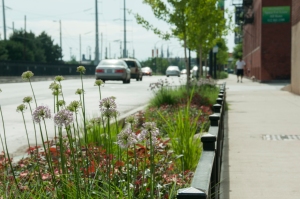Since the 19th century, most urbanized areas collect and move wastewater to Water Reclamation Plants (WRPs) using a connected collection system. In many areas, WRPs collect both storm water and wastewater in combined sewer systems. In some cities, like Chicago, Los Angeles, and New York, about 90% of the surface is “impervious.” This means that the surface does not let rainfall through.

Rainfall and snow melt make up most of the water that flows over these impervious surfaces and into the storm water system.
You may notice that during heavy rains, water collects by storm water drains. The development of cities has changed the drainage system that handles rainfall and snow melt. As a result, the amount of storm water runoff increases. During large storms, water also flows at higher heights. This can cause flooding, and burdens the WRP system. It’s very expensive to change the WRP system to support the larger amount of water.
In the last few decades, the focus has shifted from “capture, convey, and treat” traditional drainage systems. Instead, cities focus on more sustainable systems to manage storm water runoff. They are often referred to as ‘green infrastructure’. Rain gardens are one example of green infrastructure.
Cities examine green infrastructure in terms of their ability to reduce the total volume of water. Cities also look at their ability to delay the arrival of water that reaches the sewer system. This reduces the burden on the WRPs that receive the water. Reducing the water flow is also helpful because it reduces combined sewer overflows and localized flooding.
Another benefit of green infrastructure is that they can potentially reduce pollutants entering the storm water system. Pollutants like nutrients (from fertilizers), road salt, and bacteria, can negatively affect aquatic life and public health. Green infrastructure captures these pollutants, especially those that might run off at the beginning of a storm, called “first flush.”
Green based technologies collect, treat, and filter any surface runoff to recharge groundwater, helping the storm water to avoid the collections system. Green roofs, rain gardens, and other systems collect water and keep it out of storm water. Compared to traditional drainage systems, cities believe green infrastructure technologies are sustainable and will cost less for urban areas. Recently, cities are using retention ponds or vegetated swales to retain storm water runoff However; they were not suitable for older developments or metropolitan cities because they are difficult to install.
We hope you will be seeing more rain gardens, green roofs, and green infrastructure in your city!
-Answered by Kuldip Kumar and Lakhwinder Hundal, Metropolitan Water Reclamation District of Greater Chicago
To learn more, view SSSA’s Soils Support Urban Life video.
To learn more about green infrastructure and rain gardens, visit our web page About Soils.
To receive notices about future blogs, be sure to subscribe to Soils Matter by clicking on the Follow button on the upper right! Explore more on our webpage About Soils. There you will find more information about Soil Basics, Community Gardens, Green Infrastructure, Green Roofs, Soil Contaminants, materials for Teachers and more.
For further reading about rain gardens and sustainable landscapes, visit this site to download the city of Omaha’s guide.
More educational materials can be found on various SSSA websites:
http://soils4teachers.org/ (K-12 Lesson Plans and Activities)
http://soils4kids.org (Just for kids!)
http://soils.org/iys (International Year of Soils, with a coloring book and monthly ideas for teachers and scientists!)

Rain gardens are just one of several methods to detain and treat urban stormwater runoff. Before the 1970’s, urban stormwater either directly discharged to streams through run-off, or was incorporated into sewer collection systems. Both contributed greatly to surface water quality degradation through increased loadings of bacteria, nutrient, sediment, pollutants, and drastic changes to natural stream hydrology or functions. Rain gardens and other soil based systems treat the stormwater, while improving natural stream hydrology back to their natural condition and functions. This is all accomplished at a lower to compatible initial cost, but more importantly do not require long-term maintenance costs.